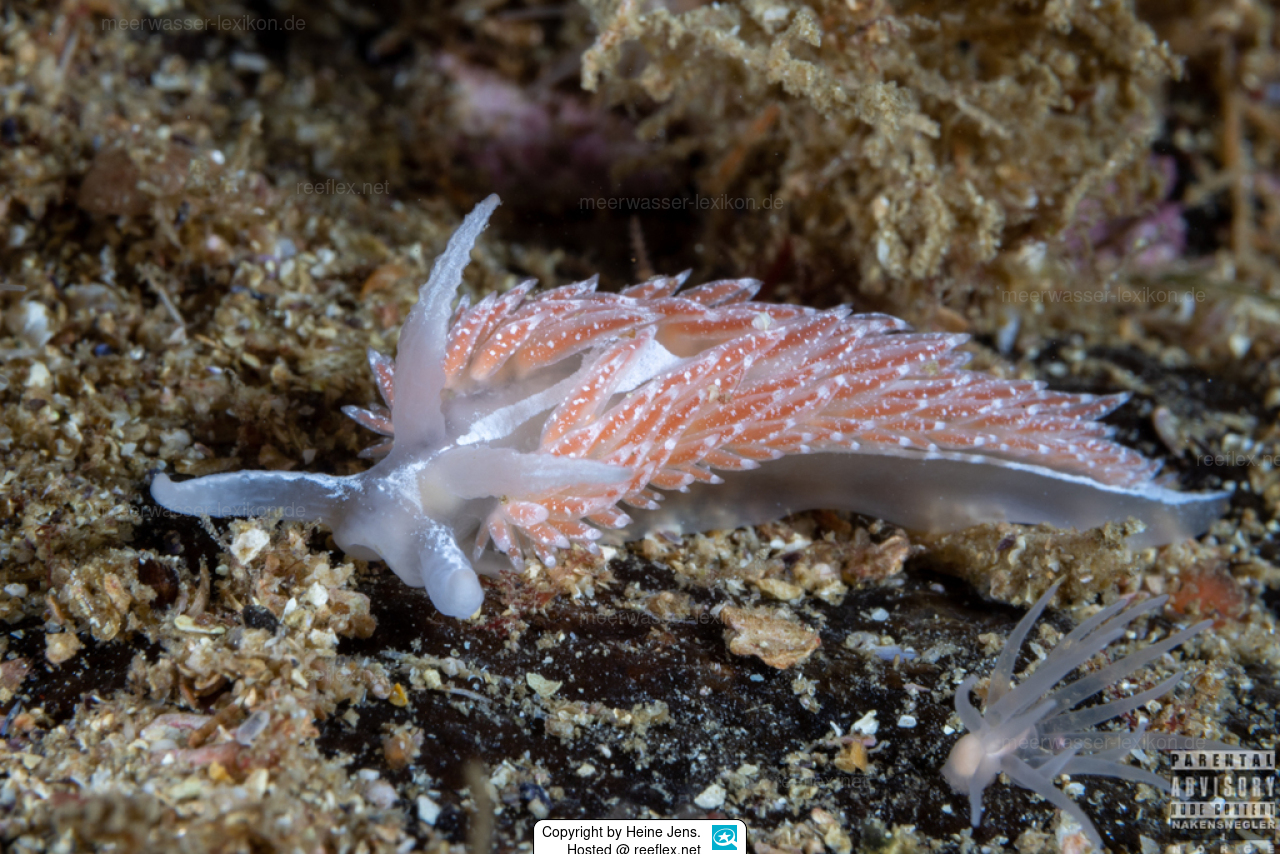Info
Coryphella orjani (Korshunova, Martynov, Bakken, Evertsen, Fletcher, Mudianta, Saito, Lundin, Schrödl & Picton, 2017)
Coryphella orjani is easily recognized by its broad dull white line on its back and its orange-red or red cerata. It occurs in areas with hard ground and many hydrozoans.
The thread snail can grow up to 40 mm and has a semi-transparent, white, wide body. It has long mouth tentacles that are 1.5 times longer than the rhinophores, which are slightly wrinkled. The cerata sit in continuous rows on the notum, are vase-shaped with a blunt tip and an elongated, pronounced nettle sack.
The intestinal tract of the cerata is reddish-brown or orange-brown, occasionally dark brown. The upper surface of the mouth tentacles and rhinophores is pigmented with a distinct dull white. The upper surface of the cerata has small white pigmented dots. On the back there is a broad dull white line from head to tail, variable in width, often extending between the base of the cerata. The tail is short. The tip of the cerata has no white pigmentation.
Coryphella orjani was described by Gülen in the Sognefjord in 2017. The distribution area extends from Gülen in the south to the Trondheimfjord in the north.
The thread snail lives in areas with Tubularia indivisa and is most commonly found at depths between 20 and 30 m. However, it feeds on hydrozoans of the genus Eudendrium, which sit on the stem of Tubularia or on the ground.
Reproduction takes place in February - May. The spawn is deposited in a tight spiral.
Coryphella orjani is almost identical to Coryphella monicae. It has a wider body and longer cerata than Coryphella monicae. Identification should be confirmed with DNA barcoding.
Etymology Synonym: Gülenia is named after Gülen at the head of the Sognefjord. This is where the Gülen Diving Center is located, which has been the starting point for much of the research on nudibranchs in recent years.
The species name "orjani" was named after Ørjan Sandnes, the owner and operator of the Gülen diving center and initiator of the annual "slug safari".
Synonymised names
Gulenia orjani Korshunova, Martynov, Bakken, Evertsen, Fletcher, Mudianta, Saito, Lundin, Schrödl & Picton, 2017 · unaccepted (original combination)
Coryphella orjani is easily recognized by its broad dull white line on its back and its orange-red or red cerata. It occurs in areas with hard ground and many hydrozoans.
The thread snail can grow up to 40 mm and has a semi-transparent, white, wide body. It has long mouth tentacles that are 1.5 times longer than the rhinophores, which are slightly wrinkled. The cerata sit in continuous rows on the notum, are vase-shaped with a blunt tip and an elongated, pronounced nettle sack.
The intestinal tract of the cerata is reddish-brown or orange-brown, occasionally dark brown. The upper surface of the mouth tentacles and rhinophores is pigmented with a distinct dull white. The upper surface of the cerata has small white pigmented dots. On the back there is a broad dull white line from head to tail, variable in width, often extending between the base of the cerata. The tail is short. The tip of the cerata has no white pigmentation.
Coryphella orjani was described by Gülen in the Sognefjord in 2017. The distribution area extends from Gülen in the south to the Trondheimfjord in the north.
The thread snail lives in areas with Tubularia indivisa and is most commonly found at depths between 20 and 30 m. However, it feeds on hydrozoans of the genus Eudendrium, which sit on the stem of Tubularia or on the ground.
Reproduction takes place in February - May. The spawn is deposited in a tight spiral.
Coryphella orjani is almost identical to Coryphella monicae. It has a wider body and longer cerata than Coryphella monicae. Identification should be confirmed with DNA barcoding.
Etymology Synonym: Gülenia is named after Gülen at the head of the Sognefjord. This is where the Gülen Diving Center is located, which has been the starting point for much of the research on nudibranchs in recent years.
The species name "orjani" was named after Ørjan Sandnes, the owner and operator of the Gülen diving center and initiator of the annual "slug safari".
Synonymised names
Gulenia orjani Korshunova, Martynov, Bakken, Evertsen, Fletcher, Mudianta, Saito, Lundin, Schrödl & Picton, 2017 · unaccepted (original combination)







 Heine Jensen, Norwegen
Heine Jensen, Norwegen



















